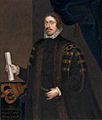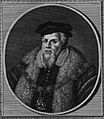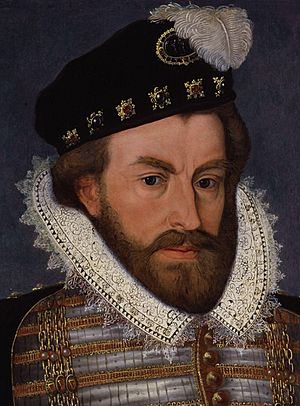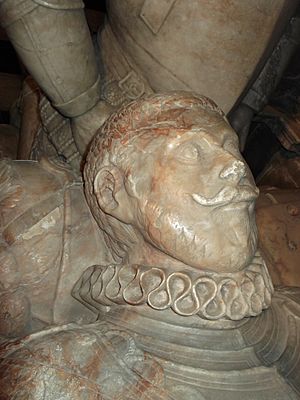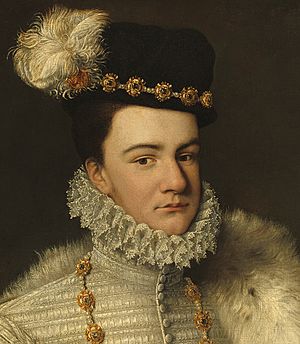Thomas Bromley facts for kids
Quick facts for kids
Sir Thomas Bromley
|
|
|---|---|
 |
|
| Lord High Chancellor of England | |
| In office c. 1579 – c. 1587 |
|
| Preceded by | Sir Nicholas Bacon (as Lord Keeper of the Great Seal) |
| Succeeded by | Sir Christopher Hatton |
| Solicitor General | |
| In office c. 1569 – c. 1579 |
|
| Preceded by | Richard Onslow |
| Succeeded by | John Popham |
| Personal details | |
| Born | 1530 |
| Died | 11 April 1587 (aged 57) |
| Resting place | Westminster Abbey, London |
| Nationality | English |
| Spouse | Elizabeth Fortescue |
| Alma mater | University of Oxford |
Sir Thomas Bromley (born 1530 – died 11 April 1587) was an important English lawyer, judge, and politician in the 1500s. He became famous during the reign of Elizabeth I. He held two very important jobs: first, he was the Solicitor General, and then he became the Lord Chancellor of England. He was in charge of the famous trial of Mary, Queen of Scots, and he passed away just three months after she was executed.
Contents
Early Life and Family
Thomas Bromley was born around 1530. He was the second son of George Bromley and Jane Lacon. His father, George, was a lawyer from Hodnet in Shropshire. His mother, Jane, came from Willey, Shropshire.
The Bromley family originally came from Staffordshire. They were part of the "landed gentry," which means they owned land and were respected, but not nobles. They worked with other families, like the Hills, to become more successful. The Hills focused on business, while the Bromleys focused on law.
Thomas's father, George Bromley, was a well-known member of the Inner Temple, a famous law school. Thomas also had an older brother, George, who became a successful lawyer and politician too. Another relative, also named Thomas Bromley, became the Chief Justice of the King's Bench.
The Bromley Family Tree
The family tree below shows how Thomas Bromley was connected to his family and important allied families like the Hills, Corbets, and Newports.
| Family Tree: the Bromleys and their allies, c. 1450–1650 | |||||||||||||||||||||||||||||||||||||||||||||||||||||||||||||||||||||||||||||||||||||||||||||||||||||||||||||||||||||||||||||||||||||||||||||||||||||||||||||||||||||||||||||||||||||||||||||||||||||||||||||||||||||||||||||||||||||||||||||||||||||||||||||||||||||||||||||||||||||||||||||||||||||||||||||||||||||||||||||||||||||||||||||||||||||||||||||||||||||||||||||||||||||||||||||||||||||||||||||||||||||||||||||||||||||||||||||||||||||||||||||||||||||||||||||||||||||||||||||||||||||||||||||||||||||||||||||||||||||||||||||||||||||||||||||||||||||||||||||||||||||||||||||||||||||||||||||||||||||||||||||||||||||||||||||||||||||||||||||||||||||||||||||||||||||||||||||||||||||||||||||||||||||||||||||||||||||||||||||||||||||||||||||||||||||||||||||||||||||||||||||||||||||||||||||||||||||||||||||||||||||||||||||||||||||||||||||||||||||||||||||||||||||||||||||||||||||||||||||||||||||||||||||||||||||||||||||||||||||||||||||||||||||||||||||||||||||||||||||||||||||||||||||||||||||||||||||||||||||||
|---|---|---|---|---|---|---|---|---|---|---|---|---|---|---|---|---|---|---|---|---|---|---|---|---|---|---|---|---|---|---|---|---|---|---|---|---|---|---|---|---|---|---|---|---|---|---|---|---|---|---|---|---|---|---|---|---|---|---|---|---|---|---|---|---|---|---|---|---|---|---|---|---|---|---|---|---|---|---|---|---|---|---|---|---|---|---|---|---|---|---|---|---|---|---|---|---|---|---|---|---|---|---|---|---|---|---|---|---|---|---|---|---|---|---|---|---|---|---|---|---|---|---|---|---|---|---|---|---|---|---|---|---|---|---|---|---|---|---|---|---|---|---|---|---|---|---|---|---|---|---|---|---|---|---|---|---|---|---|---|---|---|---|---|---|---|---|---|---|---|---|---|---|---|---|---|---|---|---|---|---|---|---|---|---|---|---|---|---|---|---|---|---|---|---|---|---|---|---|---|---|---|---|---|---|---|---|---|---|---|---|---|---|---|---|---|---|---|---|---|---|---|---|---|---|---|---|---|---|---|---|---|---|---|---|---|---|---|---|---|---|---|---|---|---|---|---|---|---|---|---|---|---|---|---|---|---|---|---|---|---|---|---|---|---|---|---|---|---|---|---|---|---|---|---|---|---|---|---|---|---|---|---|---|---|---|---|---|---|---|---|---|---|---|---|---|---|---|---|---|---|---|---|---|---|---|---|---|---|---|---|---|---|---|---|---|---|---|---|---|---|---|---|---|---|---|---|---|---|---|---|---|---|---|---|---|---|---|---|---|---|---|---|---|---|---|---|---|---|---|---|---|---|---|---|---|---|---|---|---|---|---|---|---|---|---|---|---|---|---|---|---|---|---|---|---|---|---|---|---|---|---|---|---|---|---|---|---|---|---|---|---|---|---|---|---|---|---|---|---|---|---|---|---|---|---|---|---|---|---|---|---|---|---|---|---|---|---|---|---|---|---|---|---|---|---|---|---|---|---|---|---|---|---|---|---|---|---|---|---|---|---|---|---|---|---|---|---|---|---|---|---|---|---|---|---|---|---|---|---|---|---|---|---|---|---|---|---|---|---|---|---|---|---|---|---|---|---|---|---|---|---|---|---|---|---|---|---|---|---|---|---|---|---|---|---|---|---|---|---|---|---|---|---|---|---|---|---|---|---|---|---|---|---|---|---|---|---|---|---|---|---|---|---|---|---|---|---|---|---|---|---|---|---|---|---|---|---|---|---|---|---|---|---|---|---|---|---|---|---|---|---|---|---|---|---|---|---|---|---|---|---|---|---|---|---|---|---|---|---|---|---|---|---|---|---|---|---|---|---|---|---|---|---|---|---|---|---|---|---|---|---|---|---|---|---|---|---|---|---|---|---|---|---|---|---|---|---|---|---|---|---|---|---|---|---|---|---|---|---|---|---|---|---|---|---|---|---|---|---|---|---|---|---|---|---|---|---|---|---|---|---|---|---|---|---|---|---|---|---|---|---|---|---|---|---|---|---|---|---|---|---|---|---|---|---|---|---|---|---|---|---|---|---|---|---|---|---|---|---|---|---|---|---|---|---|---|---|---|---|---|---|---|---|---|---|---|---|---|---|---|---|---|---|---|---|---|---|---|---|---|---|---|---|---|---|---|---|---|---|---|---|---|---|---|---|---|---|---|---|---|---|---|---|---|---|---|---|---|---|---|---|---|---|---|---|---|---|---|---|---|---|---|---|---|---|---|---|---|---|---|---|---|---|---|---|---|---|---|---|---|---|---|---|---|---|---|---|---|---|---|---|---|---|---|---|---|---|---|---|---|---|---|---|---|---|---|---|---|---|---|---|---|---|---|---|---|---|---|---|---|---|---|---|---|---|---|---|---|---|---|---|---|---|---|---|---|---|---|---|---|---|---|---|---|---|---|---|---|---|---|---|---|---|---|---|---|---|---|---|---|---|---|---|---|---|---|---|---|---|---|---|---|---|---|---|---|---|---|---|---|---|---|---|---|---|---|---|---|---|---|---|---|---|---|---|---|---|---|---|---|---|---|---|---|---|---|---|---|---|---|---|---|---|---|---|---|---|---|---|---|---|---|---|---|---|---|---|---|---|---|---|---|---|---|---|---|---|---|---|---|---|---|---|---|---|---|---|---|---|---|---|---|---|---|---|---|---|---|---|---|---|---|---|---|---|---|---|---|---|---|---|---|---|---|---|---|---|---|---|---|---|---|---|---|---|---|---|---|---|---|---|---|---|---|---|---|---|---|---|---|---|---|---|---|---|---|---|---|---|
|
Based primarily on the Heraldic Visitations of Shropshire and Cheshire, with assistance from the History of Parliament Online.
|
|||||||||||||||||||||||||||||||||||||||||||||||||||||||||||||||||||||||||||||||||||||||||||||||||||||||||||||||||||||||||||||||||||||||||||||||||||||||||||||||||||||||||||||||||||||||||||||||||||||||||||||||||||||||||||||||||||||||||||||||||||||||||||||||||||||||||||||||||||||||||||||||||||||||||||||||||||||||||||||||||||||||||||||||||||||||||||||||||||||||||||||||||||||||||||||||||||||||||||||||||||||||||||||||||||||||||||||||||||||||||||||||||||||||||||||||||||||||||||||||||||||||||||||||||||||||||||||||||||||||||||||||||||||||||||||||||||||||||||||||||||||||||||||||||||||||||||||||||||||||||||||||||||||||||||||||||||||||||||||||||||||||||||||||||||||||||||||||||||||||||||||||||||||||||||||||||||||||||||||||||||||||||||||||||||||||||||||||||||||||||||||||||||||||||||||||||||||||||||||||||||||||||||||||||||||||||||||||||||||||||||||||||||||||||||||||||||||||||||||||||||||||||||||||||||||||||||||||||||||||||||||||||||||||||||||||||||||||||||||||||||||||||||||||||||||||||||||||||||||||
Becoming a Lawyer
Both Thomas and his older brother, George, studied law at the Inner Temple. By 1555, Thomas was trusted at his law school. He was chosen to help manage its money. That same year, his relative, the chief justice Thomas Bromley, died. This relative left young Thomas money to help him continue his law studies.
Thomas clearly used this money well. In 1560, he earned a degree in Civil Law from Oxford University. He also gained more importance at the Inner Temple. By 1563, he was a member of the Inner Temple's parliament. In 1565, he was chosen to assist the Reader, Richard Onslow, another lawyer from Shropshire.
Bromley was also a Reader at the Inner Temple in 1566. This meant he gave lectures on law. In 1573, he was chosen to be the Lent Reader for the next year. However, this was delayed until 1575 because he was busy with Parliament.
A week later, Bromley was elected Treasurer of the Inner Temple. This meant he was in charge of the school's money. He took this job very seriously. He found the school was in debt. He worked to fix the finances, making sure everyone paid their fees. He continued as Treasurer for a third term in 1575.
- Colleagues and patrons
-
Portrait, claimed to be of Richard Onslow, a noted Puritan lawyer and Bromley's predecessor as recorder of London.
A Member of Parliament
Thomas Bromley served as a member of the Parliament of England three times. These were early in his career, before he became a major judge.
In 1558, Bromley was a Member of Parliament (MP) for Bridgnorth in Shropshire. He was about 28 years old and a lawyer. He likely got this position because of his family's connections in the area. The town often chose lawyers as their MPs.
In 1559, Bromley became an MP for Wigan. This area was controlled by the Duchy of Lancaster. The Duchy also preferred lawyers for this role.
It is clearer how Bromley became an MP for Guildford in 1563. The Earl of Arundel, a friend of Bromley and a landowner in Shropshire, helped him get this seat. Bromley later helped manage Arundel's will after he died.
In 1566, Bromley was appointed Recorder of London. This job usually meant he would become an MP for the City of London. However, Parliament decided he should continue to represent Guildford. The City of London had to choose someone else. Bromley served on committees in Parliament that dealt with legal issues and the question of who would inherit the throne after Queen Elizabeth.
Important Legal Roles
Thanks to his family and the support of Sir Nicholas Bacon, a powerful legal figure, Bromley quickly advanced in his career. He built a successful law practice, working in both the Queen's Bench (a main common law court) and Chancery (a court dealing with fairness).
He had many powerful friends and supporters, including the Earl of Arundel, Henry Carey, 1st Baron Hunsdon (the queen's cousin), Sir William Cordell, Francis Drake, and Lord Burleigh.
In 1560, Bromley advised Catherine, Duchess of Suffolk, and her husband, Richard Bertie. They were Protestants who had left England during a time of religious persecution. They had trusted their property to a lawyer, who then refused to give it back. Bromley helped them get their property returned. It was believed that Bromley only took cases he truly believed in. He had a remarkable record of not losing a case for five years.
- Clients and friends
Recorder of London
In 1566, Bromley became the Recorder of the City of London. He took over from Richard Onslow. This was an important job often held by lawyers from Shropshire.
Solicitor General
On March 14, 1569, Bromley was appointed Solicitor General, again replacing Richard Onslow. The next year, he went north to help with trials after a rebellion called the Revolt of the Northern Earls.
In 1571, Bromley played a key role in the trial of Thomas Howard, 4th Duke of Norfolk. The Duke was suspected of working with the Northern Earls and being involved in a plot called the Ridolfi plot. Bromley was very eager to prove the Duke was guilty. He presented evidence about letters and plans to invade England. Even though some of his evidence was based on rumors, it was accepted.
The next year, Bromley was sent to Sheffield to speak with Mary, Queen of Scots. The goal was to get her to give up her claims to the English and Scottish thrones. Bromley spoke about the recent plots against Queen Elizabeth. However, Mary did not agree to their demands. In 1574, he helped settle a disagreement between the city of Oxford and its university.
On April 26, 1579, Thomas Bromley was appointed Lord Chancellor. He had already become a member of the Privy Council (the Queen's closest advisors) on March 11.
Becoming Lord Chancellor
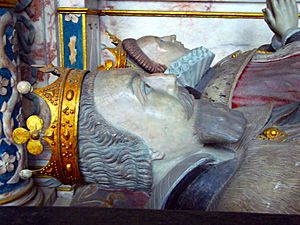
Bromley became Lord Chancellor after Sir Nicholas Bacon died in February 1579. Sir Nicholas Bacon had been Lord Keeper of the Great Seal, which had the same powers as Lord Chancellor. After Bacon's death, Queen Elizabeth kept the Great Seal herself for a while.
There was a delay in choosing the next Lord Chancellor because of political discussions. Gilbert Gerard, a very experienced lawyer, was a strong candidate. However, some people thought he was not graceful enough for such an important public role. Bromley, on the other hand, was supported by powerful figures like the Earl of Leicester and Christopher Hatton. They hoped Bromley would support the Queen's possible marriage to Francis, Duke of Anjou. Bromley was appointed both Keeper of the Great Seal and Lord Chancellor. He was knighted in May 1579.
Major Decisions as Lord Chancellor
In 1581, Bromley helped make an important legal decision in a case known as Shelley's Case. This case was about property law and was very important for many years. The Queen wanted a clear ruling on this matter.
The case of Thomas Knyvett in 1582 showed Bromley's independent judgment. Knyvett was a close friend of the Queen. He was involved in a situation where someone died. The Queen wanted Bromley to quickly clear Knyvett's name. However, Bromley refused to do so without proper legal process. He stood firm even when the Queen was unhappy.
Political and Constitutional Issues
Bromley also helped resolve important issues in Parliament. In 1581, a member of Parliament, Richard Broughton, reported that his colleague was accused of a serious crime. Bromley refused to call for a new election until the member was actually found guilty. This decision was praised by Parliament.
In 1582, the Speaker of the House of Commons died. Bromley informed the House of Lords, and they decided to ask the Queen for guidance. Bromley then told the Commons to elect a new Speaker. He also warned them not to interfere with matters concerning the Queen or the Church.
In 1582, the Queen asked Bromley for his opinion on her possible marriage to the Duke of Anjou. Bromley and his allies now opposed this marriage. Bromley pointed out that if the Queen married a Catholic, Parliament would expect her to settle the question of who would inherit the throne.
Honour and Profit
As Lord Chancellor, Bromley gained great power and wealth. In 1580, he received a special license to import wool from Ireland. This helped him support the towns in Shropshire against the claims of Chester. In 1581, Francis Drake gave him valuable Spanish gold plate that he had captured.
In 1582, Bromley used his influence to prevent changes that would have hurt the cloth trade in Shrewsbury and Oswestry. These towns were very grateful and even gave him a gift. In 1585, he gained the right to grant licenses for checking the quality of woollen cloth. This was good for him and his allies in the region.
In 1585, Bromley received a major academic honour. He was appointed deputy chancellor of Oxford University. This happened when the Earl of Leicester, the previous chancellor, left for a military expedition.
Bromley used royal grants and purchases to build up a large collection of properties. These were in Shropshire, Worcestershire, and Montgomeryshire. For example, Queen Elizabeth I granted him the Manor of Great Malvern in Malvern, Worcestershire. He also acquired the manor of Wick Episcopi. His son, Sir Henry Bromley, completed the purchase of Holt, which became the family's main home.
Conspiracies
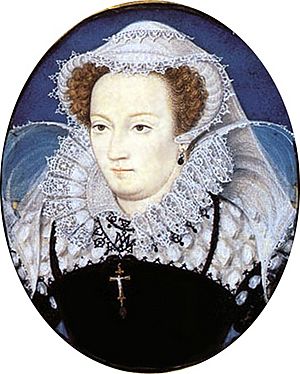
In the 1580s, there were more plots against Queen Elizabeth, often linked to Mary, Queen of Scots. In 1583, the Throckmorton Plot was discovered. Later, in 1585, the Earl of Northumberland was found dead in the Tower of London. Bromley was involved in the investigation.
In November 1585, Parliament met to discuss Mary, Queen of Scots. It was difficult to try Mary because she was not an English noble. Bromley announced a new law to allow Mary to be tried by a special court of at least 24 nobles and privy counsellors. This law was quickly passed.
In September 1586, Bromley was actively involved in the investigation and trial of Anthony Babington and his friends. Their conspiracy aimed to kill Elizabeth and put Mary on the throne. The following month, after the plotters were executed, Bromley worked to set up the court to try Mary herself.
The Trial of Mary, Queen of Scots
As Lord Chancellor, Thomas Bromley was the head of the court that tried Mary, Queen of Scots. The court had 36 members and met on November 11, 1586, at Fotheringhay Castle, where Mary was held.
Mary appeared before the court on October 14. She argued that she was a queen and could not be judged by a foreign court. Bromley read a letter from Queen Elizabeth. It stated that because Mary lived under England's protection, she had to follow English law. Bromley treated Mary with respect during the trial. However, he insisted that her royal status did not stop her from being tried in England.
The prosecution was led by Francis Gawdy, Bromley's old friend from law school. Mary admitted she knew about Babington's plan to free her. She also admitted she had thought about a French invasion. However, she strongly denied any involvement in the plan to kill Queen Elizabeth. After two days, the trial ended. The guilty verdicts were delivered on October 25.
Bromley then announced to Parliament that the trial was for a very serious reason. He explained the plots against the Queen and how God had protected her. He outlined the case to the House of Lords. Both houses of Parliament then asked the Queen to execute Mary immediately. Bromley delivered this request to Elizabeth. She agreed, but she waited until February 1, 1587, to sign the death warrant. Bromley added the Great Seal to the warrant.
Later Life and Legacy
Mary, Queen of Scots, was executed on February 7, 1587. Eight days later, Parliament met, but Bromley was too ill to attend. Edmund Anderson took his place. Thomas Bromley died on April 12, 1587, at the age of 57. He was buried in Westminster Abbey on May 2.
Some people believe Bromley's death was caused by the stress of Mary's trial and execution. However, there is no specific illness linked to this. He was not a young man for his time.
Family
Bromley married Elizabeth Fortescue by 1560. She was the daughter of Sir Adrian Fortescue, a landowner who was executed in 1539. The reasons for her father's execution are not fully clear.
Elizabeth Fortescue was one of the children from Sir Adrian's second marriage. Her brother, John Fortescue of Salden, served Princess Elizabeth and became a key figure in Queen Elizabeth's government. Another brother, Anthony, was involved in a Catholic plot. Elizabeth's brother Thomas helped arrange her marriage to Bromley.
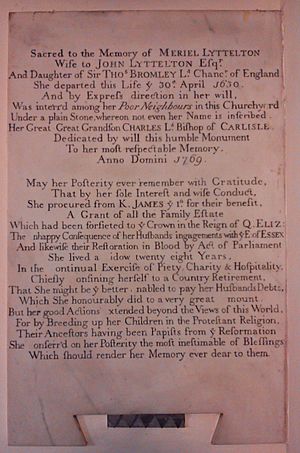
Thomas and Elizabeth Bromley had four sons and four daughters. Some of their notable children and grandchildren include:
- Sir Henry Bromley, their oldest son, became an important politician. His son,
* Thomas Bromley, was also a Member of Parliament.
- Elizabeth Bromley married Oliver Cromwell, who was the uncle of the famous Lord Protector.
- Anne Bromley married Richard Corbet, the son of a respected judge. Their son,
* Sir John Corbet, 1st Baronet, of Stoke upon Tern, was known as "the Patriot." He strongly opposed absolute monarchy and was a leader for Parliament during the English Civil War.
- Meriel Bromley married John Lyttelton. They were ancestors of the Lyttelton Baronets and Barons.
Family Tree: Descendants of Thomas Bromley
| Family Tree: Descendants of Thomas Bromley | ||||||||||||||||||||||||||||||||||||||||||||||||||||||||||||||||||||||||||||||||||||||||||||||||||||||||||||||||||||||||||||||||||||||||||||||||||||||||||||||||||||||||||||||||||||||||||||||||||||||||||||||||||||||||||||||||||||||||||||||||||||||||||||||||||||||||||||||||||||||||||||||||||||||||||||||||||||||||||||||||||||||||||||||||||||||||||||||||||||||||||||||||||||||||||||||||||||||||||||||||||||||||||||||||||||||||||||||||||||||||||||||||||||||||||||||||||||||||||||||||||||||||||||||||||||||||||||||||||||||||||||||||||||||||||||||||||||||||||||||||||||||||||||||||||||||||||||||||||||||||||||||||||||||||||||||||||||||||||||||||||||||||||||||||||||||||||||||||||||||||||||||||||||||||||||||||||||||||||||||||||||||||||||||||||||||||||||||||||||||||||||||||||||||||||||||||||||||||||||||||||||||||||||||||||||||||||||||||||||||||||||||||||||||||||||||||||||||||||||||||||||||||||||||||||||||||||||||||||||||||||
|---|---|---|---|---|---|---|---|---|---|---|---|---|---|---|---|---|---|---|---|---|---|---|---|---|---|---|---|---|---|---|---|---|---|---|---|---|---|---|---|---|---|---|---|---|---|---|---|---|---|---|---|---|---|---|---|---|---|---|---|---|---|---|---|---|---|---|---|---|---|---|---|---|---|---|---|---|---|---|---|---|---|---|---|---|---|---|---|---|---|---|---|---|---|---|---|---|---|---|---|---|---|---|---|---|---|---|---|---|---|---|---|---|---|---|---|---|---|---|---|---|---|---|---|---|---|---|---|---|---|---|---|---|---|---|---|---|---|---|---|---|---|---|---|---|---|---|---|---|---|---|---|---|---|---|---|---|---|---|---|---|---|---|---|---|---|---|---|---|---|---|---|---|---|---|---|---|---|---|---|---|---|---|---|---|---|---|---|---|---|---|---|---|---|---|---|---|---|---|---|---|---|---|---|---|---|---|---|---|---|---|---|---|---|---|---|---|---|---|---|---|---|---|---|---|---|---|---|---|---|---|---|---|---|---|---|---|---|---|---|---|---|---|---|---|---|---|---|---|---|---|---|---|---|---|---|---|---|---|---|---|---|---|---|---|---|---|---|---|---|---|---|---|---|---|---|---|---|---|---|---|---|---|---|---|---|---|---|---|---|---|---|---|---|---|---|---|---|---|---|---|---|---|---|---|---|---|---|---|---|---|---|---|---|---|---|---|---|---|---|---|---|---|---|---|---|---|---|---|---|---|---|---|---|---|---|---|---|---|---|---|---|---|---|---|---|---|---|---|---|---|---|---|---|---|---|---|---|---|---|---|---|---|---|---|---|---|---|---|---|---|---|---|---|---|---|---|---|---|---|---|---|---|---|---|---|---|---|---|---|---|---|---|---|---|---|---|---|---|---|---|---|---|---|---|---|---|---|---|---|---|---|---|---|---|---|---|---|---|---|---|---|---|---|---|---|---|---|---|---|---|---|---|---|---|---|---|---|---|---|---|---|---|---|---|---|---|---|---|---|---|---|---|---|---|---|---|---|---|---|---|---|---|---|---|---|---|---|---|---|---|---|---|---|---|---|---|---|---|---|---|---|---|---|---|---|---|---|---|---|---|---|---|---|---|---|---|---|---|---|---|---|---|---|---|---|---|---|---|---|---|---|---|---|---|---|---|---|---|---|---|---|---|---|---|---|---|---|---|---|---|---|---|---|---|---|---|---|---|---|---|---|---|---|---|---|---|---|---|---|---|---|---|---|---|---|---|---|---|---|---|---|---|---|---|---|---|---|---|---|---|---|---|---|---|---|---|---|---|---|---|---|---|---|---|---|---|---|---|---|---|---|---|---|---|---|---|---|---|---|---|---|---|---|---|---|---|---|---|---|---|---|---|---|---|---|---|---|---|---|---|---|---|---|---|---|---|---|---|---|---|---|---|---|---|---|---|---|---|---|---|---|---|---|---|---|---|---|---|---|---|---|---|---|---|---|---|---|---|---|---|---|---|---|---|---|---|---|---|---|---|---|---|---|---|---|---|---|---|---|---|---|---|---|---|---|---|---|---|---|---|---|---|---|---|---|---|---|---|---|---|---|---|---|---|---|---|---|---|---|---|---|---|---|---|---|---|---|---|---|---|---|---|---|---|---|---|---|---|---|---|---|---|---|---|---|---|---|---|---|---|---|---|---|---|---|---|---|---|---|---|---|---|---|---|---|---|---|---|---|---|---|---|---|---|---|---|---|---|---|---|---|---|---|---|---|---|---|---|---|---|---|---|---|---|---|---|---|---|---|---|---|---|---|---|---|---|---|---|---|---|---|---|---|---|---|---|---|---|---|---|---|---|---|---|---|---|---|---|---|---|---|---|---|---|---|---|---|---|---|---|---|---|---|---|---|---|---|---|---|---|---|---|---|---|---|---|---|---|---|---|---|---|---|---|---|---|---|---|---|---|---|---|---|---|---|---|---|---|---|---|---|---|---|---|---|---|---|---|---|---|---|---|---|---|---|---|---|---|---|---|---|---|---|---|---|---|---|---|---|---|---|---|---|---|---|---|---|---|---|---|---|---|---|---|---|---|---|---|---|---|---|---|
|
Based primarily on the Heraldic Visitation of Worcestershire, with assistance from the History of Parliament Online and Cokayne's Complete Baronetage.
|
||||||||||||||||||||||||||||||||||||||||||||||||||||||||||||||||||||||||||||||||||||||||||||||||||||||||||||||||||||||||||||||||||||||||||||||||||||||||||||||||||||||||||||||||||||||||||||||||||||||||||||||||||||||||||||||||||||||||||||||||||||||||||||||||||||||||||||||||||||||||||||||||||||||||||||||||||||||||||||||||||||||||||||||||||||||||||||||||||||||||||||||||||||||||||||||||||||||||||||||||||||||||||||||||||||||||||||||||||||||||||||||||||||||||||||||||||||||||||||||||||||||||||||||||||||||||||||||||||||||||||||||||||||||||||||||||||||||||||||||||||||||||||||||||||||||||||||||||||||||||||||||||||||||||||||||||||||||||||||||||||||||||||||||||||||||||||||||||||||||||||||||||||||||||||||||||||||||||||||||||||||||||||||||||||||||||||||||||||||||||||||||||||||||||||||||||||||||||||||||||||||||||||||||||||||||||||||||||||||||||||||||||||||||||||||||||||||||||||||||||||||||||||||||||||||||||||||||||||||||||||



